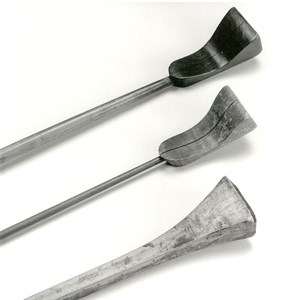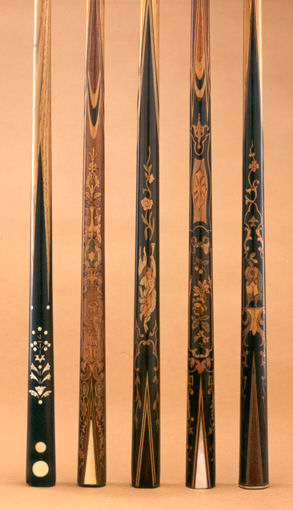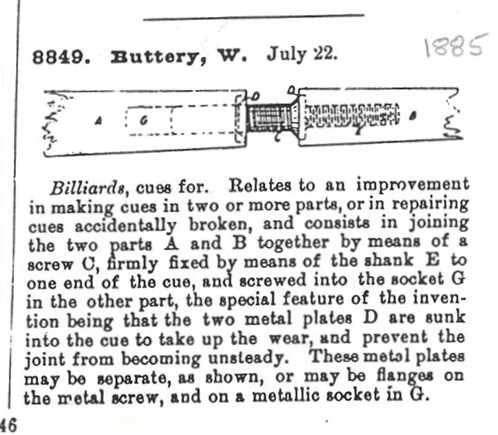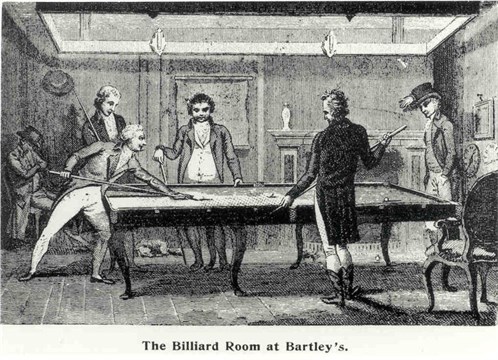Billiard Snooker Cues
BILLIARD CUES
We should first of all establish that when we are talking
about a Billiard Cue, this expression also embraces Snooker Cues.
In practise there is no difference at all between a Billiard Cue
and a Snooker Cue, although, sometimes players will state with an
air of authority that one should use a lighter cue for Billiards
than for Snooker. In practise however, the player should use
whichever weight of cue he prefers. (Since the
start of the 21st century there has been a noticeable preference
for heavier cues 17 ½ oz and more.)
We do not know who first invented a Billiard Cue. Like the
Billiard Table itself, and other accessories, it has probably
slowly evolved, reaching the present generally accepted shape and
style round about the beginning of the 19th Century.
It is accepted that cues came to England from the Continent
around about 1800. Prior to this period of time the implement used
for driving a Billiard Ball on a Billiard Table was a "Mace" .
Generally the Mace was made from Ash, and took the form of a
tapering shaft about 4ft. long, which broadened out into what I
think can best be described as a spoon shaped head, terminating
with a flat face measuring approximately 2" x 1" which was used to
push or propel the ball in the required direction.

A selection of Mace
Cues
We have here available for your inspection a very good example
of a Mace made entirely from a piece of timber. In more recent
times the head of the Mace was made from a separate piece of timber
into which the shaft was fitted.
By the early part of the 19th Century Billiard Cues as we now
know them had become firmly established, and they completely ousted
the Mace, except for the fact that the Mace did continue to be used
by lady players, and so it was sometimes called a ladies cue. The
Mace was used with one hand only, it was not necessary to form a
bridge or rest with the other hand. There is a story which suggests
that at some time in the past a player found it advantageous to
turn the mace round, and play the shot using the end of the shaft.
To do so, it was then necessary to form a bridge with the other
hand.
At this early stage, the Billiard Cue Tips had not been
invented, and so the ball had to be struck dead centre, otherwise
the cue would slip off the surface of the ball.
The actual invention of the leather cue tip is attributed
to a Frenchman named Mingaud. He is said to have been a retired
Infantry Officer who tried sticking a piece of saddle leather to
the end of his cue. One record of this event suggests that Mingaud
invented the leather cue tip in the year 1807, whilst serving a
prison sentence for airing his Political views. Evidently he was
allowed to play Billiards whilst serving his prison sentence, and
he realised that many bad shots were the direct result of the cue
slipping of the ball, and so it was that he tried a leather tip as
a means of preventing miss-cueing. On leaving prison he developed
his invention/discovery and so for many years Billiard Cue Tips
were almost entirely of French manufacture. (As a
point of interest because of the 'French' connection the size of
tips has always been in metric sizes. The only UK manufacturer of
tips was E.L. Fletcher & Son Ltd of Baldock, now part of
Peradon's the famous UK cue makers)
Bringing our thought back again to the Billiard Cue itself
- many cues are still made from Ash, although, now the most popular
timber for cue shafts is Canadian Maple, but, a very large variety
of other types of timber including Hickory and Hornbeam have been
used with complete success. In quite recent times Ramin has been
used by some Italian Cue Manufacturers.(Note; When
Norman wrote up his lecture the comments with regard to Ash and
Maple were true but after the greater interest in Snooker as a
result of T.V. coverage Ash cues became the norm. Due in no small
part to the fact that the 'new' professionals , who had picked up
old cues , that were made of Ash, when starting out set the
'fashion' for their fans etc. to follow. Ramin cues in the UK were
generally those imported from the Far East. Ramin is now on the
list of endangered trees threatened by over
felling.)
Until comparatively recent times nothing was stipulated in
the rules concerning the dimensions of a Billiard Cue, but
generally the length has been somewhere between 4ft. 8ins. and 5ft.
The present day accepted standard length in the United Kingdom
being 4ft.10ins., and we seem to have settled for a tip size
slightly less than ½" (11mm) and the present day cue has a butt
measuring approximately 1 ¼" diameter, although not many years ago
they were much broader and approximately 1½" diameter.
(Tip size on Snooker / Billiard cues now tend to be 10mm
and on UK pool cues 8.5mm. With regard to cue length in the modern
day 57 inches [145cms] to 58 inches [147 cms]).
In very recent times a rule was introduced by the Billiard
Association and Control Council, stipulating that a Billiard Cue
should not be less than 3ft. in length. This was brought about due
to the fact that a professional player - I think it was Mr Alec
Brown - used a very short piece of timber, only about 6" long with
a tip on one end to play a stroke. I understand that the referee
gave a "foul" and this resulted in very considerable argument, as
Mr Brown pointed out that this small implement was in fact one of
his Billiard cues, and that with accordance with the rules he had
played the stroke with the tip of the cue. Thereafter he adopted
the title of "The Fountain Pen Cue Man".
When during the middle years of the 19th Century, a demand for
heavier cues developed, the additional weight was obtained by
splicing/gluing on heavier pieces of timber such as Ebony to the
butt end of the cue. The art of machine splicing butts developed in
France, whilst the English method was simply to plane the sides of
the butt flat, and then to glue on the additional pieces of heavier
timber. For a time this was known as the "English Splice", although
in more recent years we have simply referred to it as being "Hand
Spliced", whilst the other method was known as the "French Splice"
and in more recent years simply as "Machine Spliced".
In very recent times, due to the high present day cost of
labour, the work of making hand spliced cues has ceased, only
machine sliced cues are now being manufactured.
(This is no longer true, checking with Peradon's, who
were established in 1885, there is a strong demand for UK made hand
spliced cues and the majority of the bespoke cues made via
their www.cuewizard.co.uk
site are hand spliced)
It is also interesting to note that during the 19th century,
many cues were manufactured with elaborately decorated inlaid
butts. Not many have survived, but we do have a few available for
your inspection, and it should be noted that even in these days
jointed cues were in fact quite popular, although many players
think that they are a very recent idea.

Billiard Cue with
decorated inlaid butts

Another Buttery patent concerning two piece cues from
1885 which shows that they were not invented in the
1970's!
Perhaps I should take this opportunity of telling you that very
few Billiard Cues are in fact perfectly straight. One often sees
players rolling a cue on the surface of the Billiard Table in order
to test it for straightness. Most cues have slight variations
somewhere along the length of the shaft - they are not perfectly
elongated tapered shafts, and so, even, a very good cue will
sometimes "lift" slightly when rolled on a table.
Unfortunately, I think for the Billiard Trade, most traders have
encouraged players to think that Billiard Cues should be perfectly
straight, and so we have made a "rod for our own backs".
If you want to examine a Billiard Cue for straightness, you
should do so by closing one eye and then sighting down the length
of the sue - rather like sighting a rifle, and then turn the cue
slowly in your hand. You will then be able to see any unevenness in
the length of the cue. Note, however, that many very good players
in fact use cues which are quite badly warped.
One other small point which may be of interest concerning the
design of Billiard Cues is the small flat area which still exists
on the butt of most cues. This is said to be handed down from the
days of the Mace, when it was permissible to play with either end
of the cue according to the wishes of the player and the stroke
required. Nowadays of course this flat surface is simply used for
the maker to fix this nameplate.
Since the original invention of the Billiard Cue Tip by Mr.
Mingaud, cue tips have also developed considerably. Double Tips,
otherwise two piece Tips, were developed during the first half of
the 19th Century - the base layer being harder than the crown, and
indeed sometimes made of fibre, whilst in quite recent times Three
Piece Tips have become very popular. The best quality tips now
being made from Chrome tanned leather, and sold under the brand
names of "Blue Diamond" and "Elk Master" which are of American
manufacture.
I should perhaps also briefly refer to the Billiard Chalk. It
seems that chalk was used on the ends of cues even before the
leather tips were used, in order to try and prevent or reduce
miscuing. It is perhaps interesting to note that even today we use
ordinary white chalk on the wooden chuck in a lathe in order to
grip a Bowling Green Bowl firmly during the turning process.
Originally the chalk used was white, but this made such a mess of
the playing surface that the green and blue Chalks were introduced,
which were not so noticeable on the green playing surface of the
Billiard Cloth.
The earliest reference I have found concerning the use of
chalk in order to give the cue a better "bite" or "grip" seems to
indicate that during the 1820's John Bartley of Bath
(see Article Past Master No 1 Kenfield &
Carr) first used chalk in order to apply "screw"
or "side" to Billiard Balls, having discovered the advantages of
using chalk for this purpose he astonished the spectators by the
shots he was then able to play.

John Carr, who acted as marker, came to know the secret, and
apparently made a small fortune by selling "twisting chalk" to
other players, with the promise that they would be able to perform
similar shots, and as many players will admit chalk on the tip of a
cue certainly makes a tremendous difference to the players ability
in controlling the cue ball.
Billiard Snooker Chalk is a manufactured commodity, and can vary
in texture and quality tremendously. Present day chalks contain a
considerable quantity of abrasive matter, and I have been told that
in recent years before the war, one well known American Chalk of
the brand name "Spinks" actually contained finely ground glass.
© Norman Clare 1990. © E.A.
Clare & Son Ltd. 2018.
Reproduction of this article allowed only with the permission from
E.A. Clare & Son Ltd.
www.thurston.co.uk
to contact us by phone
0151 482 2700
or
email - thurston@eaclare.co.uk
Go to top of page

